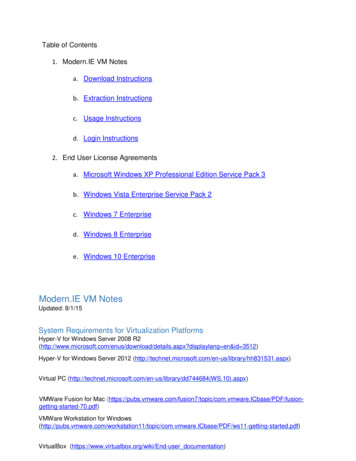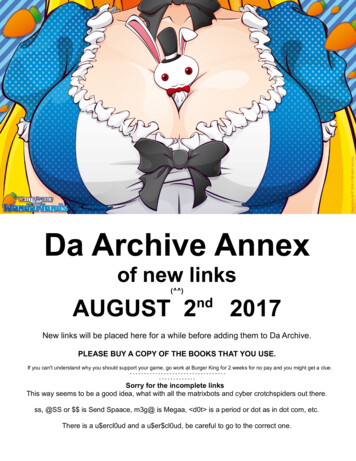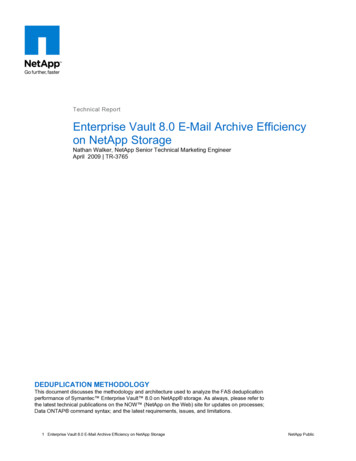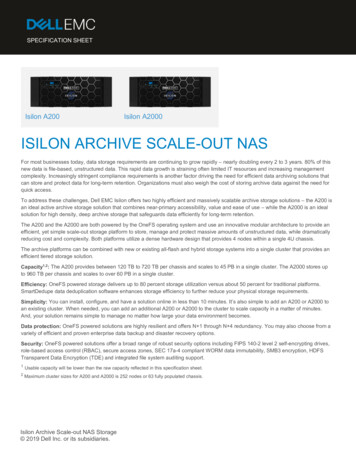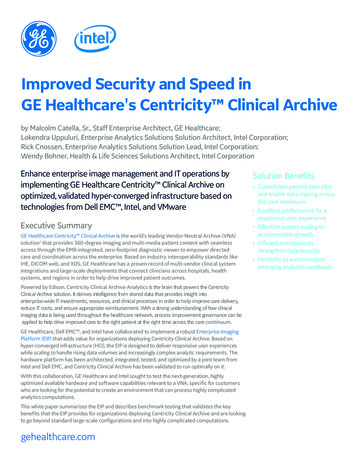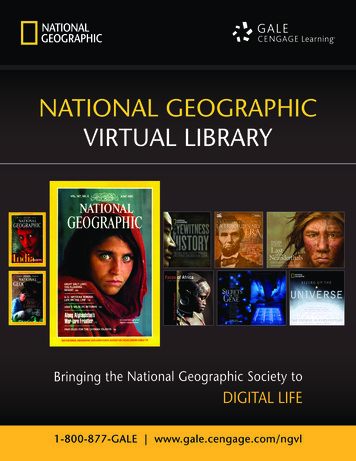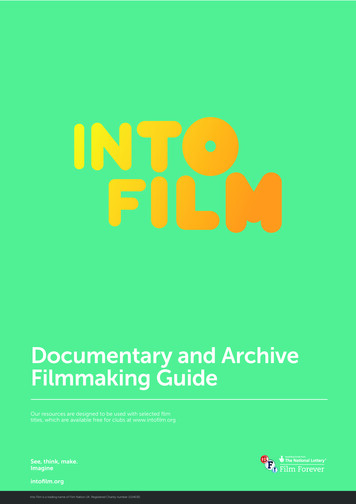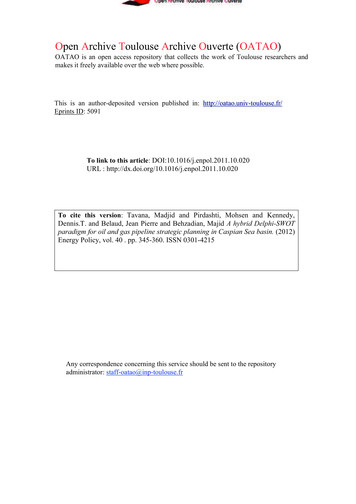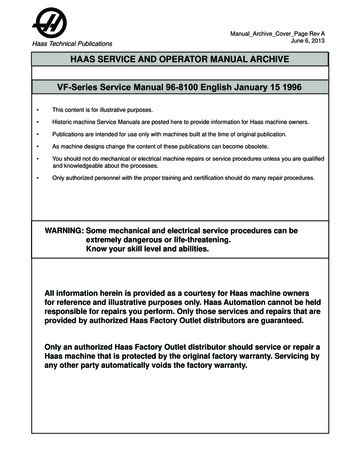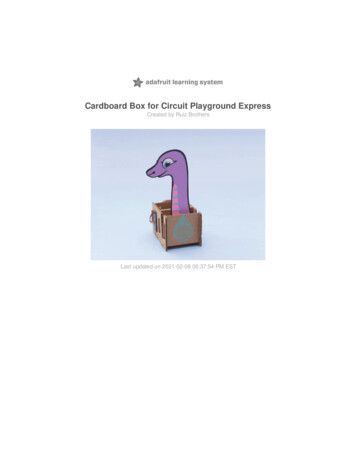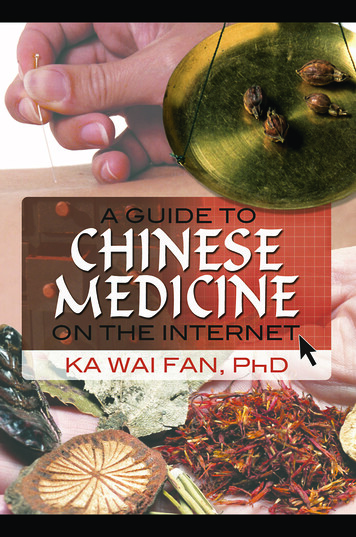
Transcription
A Guide to ChineseMedicine on the Internet
A Guide to ChineseMedicine on the InternetKa wai Fan, PhD
First published 2008by Routledge270 Madison Ave, New York, NY 10016Simultaneously published in the UKby Routledge2 Park Square, Milton Park, Abingdon, Oxon OX14 4RNRoutledge is an imprint of the Taylor & Francis Group, an informa businessThis edition published in the Taylor & Francis e-Library, 2008.“To purchase your own copy of this or any of Taylor & Francis or Routledge’scollection of thousands of eBooks please go to www.eBookstore.tandf.co.uk.” 2008 Taylor & FrancisAll rights reserved. No part of this book may be reprinted or reproducedor utilised in any form or by any electronic, mechanical, or other means,now known or hereafter invented, including photocopying and recording,or in any information storage or retrieval system, without permission inwriting from the publishers.Trademark Notice: Product or corporate names may be trademarks orregistered trademarks, and are used only for identification and explanationwithout intent to infringe.Due to the ever-changing nature of the Internet, Web site names andaddresses, though verified to the best of the publisher’s ability, should notbe accepted as accurate without independent verification.Cover design by Jennifer M. Gaska.Library of Congress Cataloging in Publication DataA guide to Chinese medicine on the Internet / Ka Wai Fan.p.; cm.Includes bibliographical references.1. Medicine, Chinese—Computer network resources—Directories. 2.Internet addresses—Directories. 3. Web sites—Directories. I. Title.[DNLM: 1. Medicine, Chinese Traditional—Resource Guides. 2.Internet—ResourceGuides. WB 39 F199g 2007]R601.F283 2007610.285025—dc222007045395ISBN 0-203-89430-8 Master e-book ISBNISBN10: 0-7890-3199-X (hbk)ISBN10: 0-7890-3200-7 (pbk)ISBN10: 0-2038-8932-0 (ebk)ISBN13: 978-0-7890-3199-0 (hbk)ISBN13: 978-0-7890-3200-3 (pbk)ISBN13: 978-0-2038-8932-9 (ebk)
This project has taken nearly two years to compile. I wouldlike to express my heartfelt thanks to Fiona S. N. Lau, FrancesTin, Samuel Gilbert, and Dr. G. A. Plum for their help.
ABOUT THE AUTHORKa wai Fan, PhD, is a full-time lecturer in the Chinese CivilizationCenter, City University of Hong Kong; an honorary adjunct assistantprofessor in the School of Chinese Medicine at the Chinese University of Hong Kong; and honorary visiting fellow (2006-2009) at theCenter for Traditional Chinese Science and Civilization in The Institute for the History of Natural Science, Chinese Academy of Sciences, Beijing. He received his PhD, MPhil, and BA all from the Department of History, Chinese University of Hong Kong. He workedas an assistant professor in the Institute of History, National Tsinghua University, Taiwan. His research interests include the history ofChinese medicine and online information on Chinese medicine. Hehas written several publications on both the online resources of Chinese medicine, and the history of Chinese medicine.
CONTENTSIntroductionChinese Medicine As Complementary and AlternativeMedicine (CAM)How to Evaluate Web sites Related to Chinese MedicineThe Basic Terms of Chinese MedicineClassification of Web sites on Chinese MedicineAssumptionsChapter 1. Portals and General Web SitesGeneral Chinese CultureTraditional Chinese MedicineAcupunctureHerbalTaiji and Chinese MassageDigital MuseumsChapter 2. OrganizationsChinese Medicine, Traditional Medicine, and OrientalMedicineAcupunctureHerbalQigong and Related FieldsCAM or Related OrganizationsChapter 3. UniversitiesOrganizations127128Chapter 4. Schools139Greater China (China, Taiwan, Hong Kong, and Macau)North America (United States and Canada)Europe and Australia141145151
Chapter 5. JournalsGeneralAcupunctureHerbalQigong and Related SitesCAM JournalsNewslettersHistory and PhilosophyChapter 6. Databases, Bibliographies,and Electronic TextsDatabasesJournals and 00227240Chapter 7. History and Philosophy251Index269
IntroductionOver the past few decades, Chinese medicine, being a kind of complementary and alternative medicine (CAM), has become a growingfocus all over the world. This is because Traditional Chinese Medicine (TCM) has been playing an important role in the preventionand cure of diseases and the prolongation of life, through methodssuch as acupuncture, herbal therapies, and Qigong. More and morepeople are paying attention to Chinese medicine, although the Chinese medical system is a non-Western medical system.1The Internet is being increasingly used in conjunction with research: to share information; to disseminate findings; and to publicize projects and organizations. At the same time, the ability to siftthrough the ever-increasing amounts of information made availableonline to find quality and accurate data is becoming more importantevery day. The Internet is a very important search tool for facultymembers and students. Currently, many disciplines are dependenton the Internet for the dissemination of information. In fact, manyprofessors and scholars use online resources to pursue their own research.2 However, simply using a search engine, such as Google orYahoo, to look for information will not necessarily lead one to quality resources, and is more likely to provide a large number of unordered results to sift through. Many useless items are also included inthe results, and the quality or reliability of the search results cannotbe ensured. In a survey of the information available on the WorldWide Web (WWW) about the use of herbal medicine in the treatment of cancer, most sites were found to be inadequate in a numberof areas, including bias, accuracy, clear presentation of sources ofinformation, and regularity of updates.3A Guide to Chinese Medicine on the Internet1
2A GUIDE TO CHINESE MEDICINE ON THE INTERNETA great deal of Chinese and English-language information aboutChinese medicine is available online. However, this information isnot reviewed by experts and the authors of such information may notbe professionals in the field represented by the information. Manypeople are concerned that the information about Chinese medicinethat is available on the Internet may be wrong, useless, and evenharmful if followed without further advice. The purpose of this bookis to provide a guide to the information about Chinese medicine thatis available on the WWW in order to help interested people find upto-date and reliable information and learn about new developmentsin Chinese medicine easily and quickly. It should be noted that thebook does not encourage the use of any particular Chinese medicaltherapy for the treatment of any disease. If readers want to use Chinese medicine for treatment purposes, they should consult their doctor or a qualified professional rather than accept at face value what isstated on a Web site. Any information posted on the Internet should onlybe used for reference purposes, not for making any treatment decision.Although there are guides available for CAM online resources,4 theredoes not seem to be any publication that functions as a guide to usingthe Internet to research Chinese medicine.5 This book provides a categorized listing of Web sites related to Chinese medicine, with a briefdescription of each site’s content. In addition, it discusses guidelines forsearching, cataloging, and evaluating Web sites concerned with Chinese medicine based on the author’s personal experience as a user.CHINESE MEDICINE AS COMPLEMENTARYAND ALTERNATIVE MEDICINE (CAM)In 1998 the United States government established The NationalCenter for Complementary and Alternative Medicine (NCCAM) asone of the twenty-seven institutes and centers that make up the renowned National Institutes of Health (NIH) within the U.S. Department of Health and Human Services. NCCAM is dedicated to exploring complementary and alternative healing practices in the contextof rigorous science; to training CAM researchers; and to disseminating authoritative information to the public and to professionals. So
Introduction3what is CAM? As defined by NCCAM, CAM is a group of diversemedical and health care systems, practices, and products that are notpresently considered part of conventional medicine. Complementarymedicine is used together with conventional medicine. Alternativemedicine is used in place of conventional medicine.What is the meaning of “conventional medicine”? Conventionalmedicine is medicine as practiced by holders of MD (medical doctor)or DO (doctor of osteopathy) degrees and by allied health professionals, such as physical therapists, psychologists, and registered nurses.Terms for conventional medicine include allopathy; Western, mainstream, orthodox, regular medicine, and biomedicine. Some conventional medical practitioners are also practitioners of CAM.6 As NCCAMis an authoritative institute, its definition is widely accepted. ManyCAM Web sites copy this definition and link it to NCCAM.Under “Medical Subject Healings” the National Medical Libraryhas an entry headed “Alternative Medicine” (also used in MEDLINE): “An unrelated group of non-orthodox therapeutic practices,often with explanatory systems that do not follow conventional biomedical explanations” (MeSH Term Working Group, NIH, 1993).Between 1963 and 1993, the relevant entry had been headed “Therapeutic Cults” and read “non-orthodox therapeutic systems whichhave no satisfactory scientific explanation for their effectiveness.”7Presently, the description of alternative medicine or complementary medicine (with a definition of “alternative medicine” combinedwith that of “complementary therapies”) under the heading “MedicalSubject Healings” in the National Medical Library reads:Therapeutic practices which are not currently considered an integral part of conventional allopathic medical practice. Theymay lack biomedical explanations but as they become betterresearched some (physical therapy, diet, acupuncture) becomewidely accepted whereas others (humors, radium therapy) quietly fade away, yet are important historical footnotes. Therapiesare termed as complementary when used in addition to conventional treatments and as alternative when used instead ofconventional treatment.8
4A GUIDE TO CHINESE MEDICINE ON THE INTERNETThe difference between the two descriptions is very apparent. Theformer bluntly stated that CAM had no satisfactory scientific explanation for the effectiveness of any therapies, whereas the latter—whilestill stating that CAM may lack biomedical explanations—concedesthat some CAM therapies may become widely accepted as they become better researched.The Alternative Medicine Homepage is maintained by Universityof Pittsburgh librarian Charles Wessel, who is an authority on CAMInternet resources. He provides three definitions on his Web site. Thefirst definition cites the National Library of Medicine stated previously. The second definition states that “[CAM] as medical interventions [are] not taught at United States medical schools or [are]not available at United States hospitals.” This definition comes fromDavid Eisenberg of the Harvard Medical School, who with his colleagues conducted surveys into the use of CAM in the United Statesbetween 1993 and 1998. Eisenberg says that “Alternative Medicinecan be defined as medical interventions that are neither taught widelyin US medical schools nor generally available in US hospitals.”9 Thisdefinition first appeared in an article by Eisenberg in 1993 and wasrepeated in another article in 1998. David Eisenberg’s articles arewidely cited and his definitions have therefore found their way ontothe Web.The third definition provided on the Alternative Medicine Homepage comes from the Panel on Definition and Description, CAM Research Methodology Conference, Office of Alternative Medicine,National Institutes of Health, Bethesda, Maryland, April 1995:Complementary and alternative medicine as a broad domain ofhealing resources that encompasses all health systems, modalities, and practices and their accompanying theories and beliefs,other than those intrinsic to the politically dominant health system of a particular society or culture in a given historical period. CAM includes all such practices and ideas self-defined bytheir users as preventing or treating illness or promoting healthand well being. Boundaries within CAM and between the CAMdomain and the domain of the dominant system are not alwayssharp or fixed.10
Introduction5This definition does not focus on distinguishing between CAM andconventional medicine; instead, CAM is viewed as a collection ofhealing resources with its own theories and beliefs.The Oxford Concise Medical Dictionary is written by medicalexperts, and updated from time to time. The Oxford Concise Medical Dictionary (fifth edition, 1998) has the following entry under theheading “alternative medicine”:The various systems of “healing” including homeopathy, herbalremedies, hypnosis and faith healing, that are not regarded aspart of orthodox treatment by the medical profession, especially when offered by unregistered practitioners. Most of thetreatments are of unproven benefit but are tried by sufferers ofchronic or incurable conditions when orthodox treatment hasfailed. Many alternative therapies are ridiculed by the medicalprofession, but acupuncture and osteopathy are now generallyaccepted to be of value in some circumstances. The extent towhich individual registered practitioners indulge in or spurnthese therapies varies enormously but is governed by the overriding principle (laid down by the General Medical Council)that shared care is only permitted if the registered practitionerremains in overall control; this is often unacceptable to thosepracticing alternative medicine.11Alternative medicine is defined as not being part of orthodoxmedicine; the examples of therapies given only serve the point of letting us know what therapies belong under the heading of alternativemedicine, without thereby “approving” of them in any way. According to the dictionary, alternative medicine may be said to have thefollowing four major characteristics: (1) It is a healing (or medical)system but not part of orthodox medicine; (2) it is offered by unregistered practitioners, not the medical profession; (3) the treatmentsof alternative medicine are of unproven benefit; and (4) sufferers usealternative medicine when orthodox treatment has failed. In addition,the dictionary offers no description of “complementary medicine”directing readers to go to a cross-reference “see alternative medicine.”
6A GUIDE TO CHINESE MEDICINE ON THE INTERNETIn 2002, the Oxford Concise Medical Dictionary published itssixth edition. It is interesting that there is now no entry “alternative medicine” it having been replaced by an entry: “complementarymedicine,” thus only directing us to “see complementary medicine,”which is described as follows:Complementary medicine—various forms of therapy that areviewed as complementary to conventional medicine. These include (but are not confined to) osteopathy, acupuncture, homeopathy, massage, reflexology and reiki. Previously, complementary therapies were regarded as an alternative to conventionaltherapies, and the two types were considered to be mutuallyexclusive (hence the former names alternative medicine andfringe medicine). However, many practitioners now have dualtraining in conventional and complementary therapies. There isvery limited provision for complementary medicine within theconfines of the National Health Service.12The difference between the two editions is very noticeable, thesixth edition having effectively recast alternative medicine as complementary medicine. No longer being placed in an oppositionalposition to conventional medicine, complementary medicine is nowviewed as complementary to conventional medicine.13 According tothe sixth edition of the dictionary, complementary medicine may besaid to have the following three major characteristics: (1) CAM isused as complementary to conventional medicine, to be used whenconventional medicine has failed; (2) CAM is offered by many registered practitioners who are trained in both conventional and complementary therapies; (3) The National Health Service in the UnitedKingdom also provides some (although very limited) complementary therapies for sufferers. The changed definitions in the two editionsundoubtedly reflect a growth in the medical profession’s understanding of CAM and also observable trends in the provision of CAM.To sum up, the definitions reflect our changing understanding ofCAM. Previously, as the Oxford Concise Medical Dictionary (fifthedition) pointed out, many alternative therapies were ridiculed bythe medical profession. One of the differences between CAM and
Introduction7conventional medicine is that CAM is considered to be nonscientific.Marcia Angell and Jerome Kassirer say thatIt [CAM] has not been scientifically tested and its advocateslargely deny the need for testing. . . . Alternative medicine alsodistinguishes itself by an ideology that largely ignores biologicmechanisms, often disparages modern medicine science, andrelies on what are purported to be ancient practices and naturalremedies.14It is difficult for the medical profession to accept CAM whenCAM is defined as nonscientific and is not taught in medical schools.However, when searching for CAM information online, the authorfinds that, first, more and more professional medical journals publishresearch, case reports, and clinical reports about CAM, and CAMjournals also state that published articles are peer-reviewed and basedon scientific and biomedical research.Second, according to a survey, there is tremendous heterogeneityand diversity in content, format, and requirements among courses incomplementary and alternative medicine at U.S. medical schools.15For example, the Stanford University Faculty of Medicine provides aCAM program on the topic of “Successful Aging.”16Third, university libraries, such as those at the University of British Columbia and McMaster University,17 provide professional CAMinformation on the Web. Special research centers have also been established, such as the Oregon Center for Complementary and Alternative Medicine in neurological disorders, and the Richard and Hinda Rosenthal Center for Complementary and Alternative Medicineat Columbia University.18 Many research centers for CAM therapiesare funded by NACCM. In other words, CAM is not being totallyrejected by the university medical education system.Chinese medicine, as part of CAM, also shows these trends. Chinese medicine, including acupuncture, Qigong and herbals, continually edges toward the mainstream of conventional medicine, andmore serious research is being conducted both scientifically andclinically. Using scientific methods to study Chinese medicine isnow mainstream. In some European countries and the United States,
8A GUIDE TO CHINESE MEDICINE ON THE INTERNETthere are regulations governing the practice of Chinese medicine,especially acupuncture treatment. Many medical journals publisharticles related to Chinese medicine in the English-speaking world.The University of Westminster and the University of Middlesex, bothin the United Kingdom, provide degree courses in Chinese medicine,of course using English to teach.In Chinese people’s minds, Chinese medicine is not CAM. Although universities of TCM in China teach Chinese medicine, halfof their courses actually teach Western medicine, and research intoChinese medicine in China emphasizes the integration of Chineseand Western medicine. What is Chinese medicine? This question isvery difficult to answer. NCCAM offers the following definition ofTCM:Traditional Chinese Medicine (TCM) is the current name foran ancient system of health care from China. TCM is based ona concept of balanced Qi (pronounced “chee”), or vital energy,that is believed to flow throughout the body. Qi is proposedto regulate a person’s spiritual, emotional, mental, and physical balance and to be influenced by the opposing forces of yin(negative energy) and yang (positive energy). Disease is proposed to result from the flow of Qi being disrupted and yin andyang becoming imbalanced. Among the components of TCMare herbal and nutritional therapy, restorative physical exercises, meditation, acupuncture, and remedial massage.19NCCAM’s description seems only to emphasize the concept of Qi.Actually, Chinese medicine is based on philosophical systems (thetheories of yin-yang, five phases and Qi), the view of the body (zangfu—internal organs) system, system of Meridians, acupoints), thecauses of diseases, diagnosis, treatments, etc. Wikipedia describesthe TCM as follows:Traditional Chinese Medicine is a range of traditional medicalpractices used in China that developed during several thousandyears. These practices include herbal medicine, acupuncture,and massage. TCM is a form of Oriental medicine, which in-
Introduction9cludes other traditional East Asian medical systems such as Japanese and Korean medicine. TCM says processes of the humanbody are interrelated and constantly interact with the environment. Therefore the theory looks for the signs of disharmonyin the external and internal environment of a person in order tounderstand, treat and prevent illness and disease. TCM theoryis based on a number of philosophical frameworks includingthe Theory of Yin-yang, the Five Elements, the human bodyMeridian system, Zang Fu theory, and others. Diagnosis andtreatment are conducted with reference to these concepts. TCMdoes not usually operate within a scientific paradigm but somepractitioners make efforts to bring practices into an evidencebased medicine framework.20Wikipedia’s description of Chinese medicine is very concise andclear.HOW TO EVALUATE WEB SITES RELATEDTO CHINESE MEDICINEHow does one evaluate the advantages and disadvantages of Websites? This is a very critical point when searching on the Internet.However, due to each discipline having its own rules and practices,it is very difficult to arrive at general rules that are suitable for alldisciplines. Robert Harris’s CARS Checklist is a general tool thatoffers some general criteria for evaluating the quality of Web sites.A summary of the CARS Checklist for Research Source Evaluationfollows: Credibility: Trustworthy source, author’s credentials, evidenceof quality control, known or respected authority, organizationalsupport. Accuracy: Up-to-date, factual, detailed, exact, comprehensive,audience and purpose reflect intentions of completeness and accuracy.
10A GUIDE TO CHINESE MEDICINE ON THE INTERNET Reasonableness: Fair, balanced, objective, reasoned, no conflictof interest, absence of fallacies or slanted tone. Support: Listed sources, contact information, available corroboration, claims supported, documentation supplied.21These are general rules for the evaluation of Web sites. Medicaland medicine-related Web sites are likely to make suggestions fortreatment or guide readers to adopt / give up some form of treatment.Therefore, the accuracy and reliability of the information providedmay well be affected by the author’s opinions and have resulted inthe information being subjective rather than objective. The authorbrowsed the Web for the topic “how to evaluate medical informationon the Internet,” and found that the criteria used for evaluation ofsuch information show no great differences.There are a number of questions any user of the Web interested inmedical information should ask: Who is providing the information?Who is paying for the site? Web sites by governments, universities, orother academic institutions, professional associations, and researchfoundations are among the best sources for scientifically sound healthand medical information. What is the purpose of this page? Who isthe intended audience? Is the information on this Web site peer-reviewed? Is the information based on scientific evidence and evidencebased medicine? In addition, the reader should be very careful whenconsulting Web sites that sell pharmaceuticals and provide medicalservices. It is not easy, and perhaps impossible, for people who arenot medical experts to differentiate between Web sites that offer information based on scientific evidence and evidence-based medicineand those whose information is not scientifically based.Lillian Brazin, in her book Guide to Complementary and Alternative Medicine on the Internet, offers one more piece of advice, whichis to look out for an official “seal of approval”:Does it bear the “HONCode” logo? (This code is awarded tosites that meet the HONCode of Conduct). . . . its (Health onthe Net Foundation) mission is to guide Internet searchers toreliable and useful online medical and health information. Itsets ethical standards for those who develop health and medi-
Introduction11cal Web sites. . . . URAC (American Accreditation HealthcareCommission) aims to help consumers identify sites that meethigh accountability and quality standards. URAC lists the accredited Web sites with the name of the company that producesthe sites. The sites are reviewed annually, and the date the accreditation expires is listed. . . . For a good guide to determininga CAM site’s credibility or the validity of its claims, check outQuackwatch (http://www.quackwatch.com).22This is a good suggestion, but unfortunately only a few Web sites areevaluated by the Health on the Net Foundation, the American Accreditation Healthcare Commission, or Quackwatch.Generally speaking, Web sites about Chinese medicine shouldprovide information that is credible and accurate, and the approachtaken to information should be a reasonable one. It is just as important that the site’s design is user-friendly, i.e., information is easy tofind and readable, and the icons are easy to use, etc.Another issue of the Web site is its accessibility, which requires thehost server to be stable and always online. According to the author’sexperience, Web sites in Mainland China are often disconnected andeven missing, and are slow to download Web pages.As mentioned, Web sites provided by governments, universities,academic institutions, professional associations, research foundations, and nonprofit organizations are among the best sources of scientifically sound health and medical information. The most reliableauthors of information available on the Web are professional associations that publish or co-publish academic journals (not newsletters),preferably with reputable publishers.If readers want to know the effectiveness of the treatment of Chinese medicine, they should consult searchable journal databases,such as Academic Search Premier, ProQuest, ScienceDirect, Springerlink, ISI Thomas, Elsevier Wiley Science, etc. Much informationcan be found on these databases. You may say that, “I do not pay fora subscription, so I will not be able to see the full text” or “I am nota doctor, so what are the advantages of browsing these databases?”As most of the journals in these databases are peer-reviewed, reading the abstract of an article is a good way to start—especially since
12A GUIDE TO CHINESE MEDICINE ON THE INTERNETabstracts are both published in full and freely available. Generallyspeaking, abstracts of medical articles include purposes, methods,and results.A Web site may also provide good suggestions for further searching information on Chinese medicine. As the Web site of CaliforniaMedial Association points out, take advantage of Internet reviewsand annotated links to other internet resources. For some health andmedical topics, there are an overwhelming number of possible sources of information. How can you tell which of the many sources areworth exploring? Good starting points are sites that collect links toresources by topic, and particularly useful are those that also reviewsites, using expertise from experts, practitioners, and/or librarians.Some examples of such collected and reviewed lists are Medical Matrix, HealthWeb, Health and Medical Informatics Digest, MedWeb,and some of the sites of professional medical organizations as well asuniversity or research sites. Published guides, like the many Internetbooks now in print, may provide useful pointers but can be out-ofdate quickly due to the volatile nature of the Internet.23Readers should familiarize themselves with two or three reliableWeb sites about Chinese medicine, sites you can trust or that havebeen reviewed or at least mentioned favorably in books or by experts.If you find a new Web site that seems to contradict much of what isfound on a site that is familiar to you, you should be very careful.NCCAM reminds you of what you should know and avoid. TheNCCAM Web site identifies the medical circumstances under whichcomplementary and alternative therapies are appropriate; explainshow to find out what scientific studies have been done on the safetyand effectiveness of specific treatments; and offers guidelines aboutevaluating statements made about the effectiveness of a given therapy.THE BASIC TERMS OF CHINESE MEDICINEAfter browsing many Web sites about Chinese medicine, readerswill have come across a variety of basic concepts, terms, and theories of Chinese medicine. In order to assist readers in browsing the
Introduction13Web sites listed in this book, the author has selected thirty-six termsand provided very brief descriptions (according to the authoritativereferences). The author also recommends Chen Hua’s book Zhong yide ke xue yuan li (Outline of Sinomedicine, available at: http://healther.stormloader.com),24 as it offers descriptions of Chinese medicalterms and theories. It may be seen as an introduction to Chinesemedicine.acupressure: A method of treatment involving the application offinger pressure at acupuncture points.25acupuncture: The practice of puncturing the body with metalneedles (steel, gold,
First published 2008 by Routledge 270 Madison Ave, New York, NY 10016 Simultaneously published in the UK by Routledge 2 Park Square, Milton Park, Abingdon, Oxon OX14 4RN Routledge
